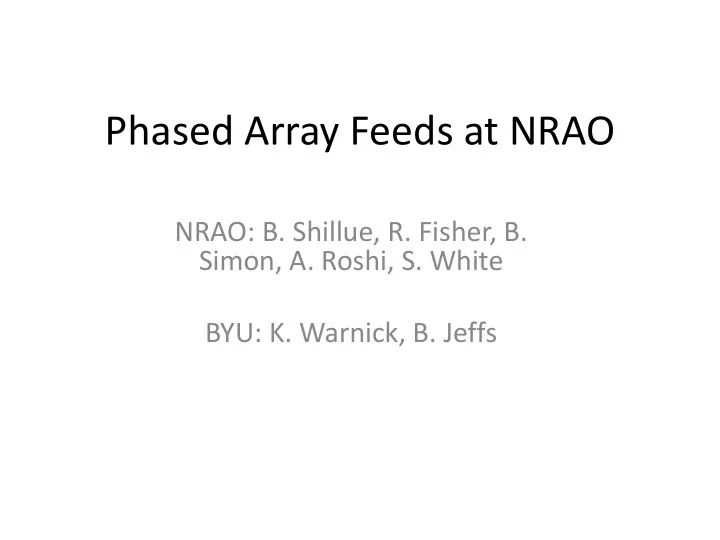

Phased Array Feeds at NRAO NRAO: B. Shillue, R. Fisher, B. Simon, A. Roshi, S. White BYU: K. Warnick, B. Jeffs
PAF Concept Combine multiple small elements with appropriate complex weights to form multiple beams and optimize Field-of-View and increased Survey Speed
PAF Context: History and NRAO Development • Initial Concepts and Early Experiments: 1995-2008 • 2008 to present: – Pre-SKA search for new paradigms begins to push PAF to front burner: SKA and APERTIF. These are large, uncooled, high N(element count) and mid M (# antennas) – US-based groups R&D effort based on single dish, cooled receivers (NRAO, BYU, Cornell) – At NRAO this is the F ocal L -Band Array for the G BT (FLAG)
NRAO Focal L-Band Array for GBT (FLAG) Thin Dipoles 20-meter 2007 Sinuous elements 140-ft 1996 Thick, impedance-optimized dipoles, Present FLAG Receiver, “Kite Dipoles” 20-meter, 2011
NRAO Focal L-Band Array for GBT (FLAG) – 19 element low loss, high effficiency active impedance matched array – 19 x 2 element dual-polarized array – Cryogenic dewar 2-stage closed cycle refrigerator, SiGe LNAs, Downconverter and Digitizer back end – Multichannel (40) analog downconverter boards – 40 channel narrowband data acquisition system – Stream-to-disk, software based correlation and beamforming
Recently… • GBT test: 1 st test of FLAG PAF on GBT, December 2013 • M&C and Observing: Integration of PAF into GBT Monitor and Control • Modeling and Analysis: Full 19-element model of dipole, LNAs, complex weighting • Downconverter Data Link upgrade: Dowconverter, Digitization, and signal transmission in a compact 8x5 40-channel electronics module co-located with the Front End • Beamformer Project: 2013 NSF ATI grant to BYU-WVU- NRAO collaboration on wideband digital backend
NRAO PAF Receiver Cooled LNA receiver-dewar, CTI-102 refrigerator, 19 element dual polarization • 7
Dipole Elements “Kite” Element, BYU design for 20-m telescope New GBT2 Element, BYU design 2013, optimized for best efficiency on GBT (over seven dimension parameters): Element pattern • Bandwidth • • Impedance 8
Dual-Polarization LNAs and Thermal Transition NXP SiGe transistors. Thin-wall SS tubular coax. Quartz beads for vacuum seal and center conductor heat sink. Pair of two-channel LNAs with integrated low-loss coaxial lines for transition from 15 to 300K LNA design based on: S. Weinreb, J. Bardin, H. Mani, G. Jones, “Matched wideband low- noise amplifiers for radio astronomy”, Rev. of Sci. Instr., vol. 80, 044702, 2009. 9
Phased Array Technologies • Receiver element design and modeling : bandwidth, element pattern, impedance • Amplifier design : device, gain, reliability • Front end and cryo design : Thermal transition, balun, maintainability • Downconversion and signal transport : fiber link design, moving toward digital • Beamforming and Correlation : real time digital backend • Modeling : Theory vs measurement • Observing and mapping
“Beamformer” Project • External NSF ATI project funded in Sept 2013 • Wideband 150/300 MHz downconverter and digital backend project • Digital data link • Roach2 based 40-channel polyphase filterbank • Correlation and Beamforming by GPUs • Supporting HI and Pulsar Science
Instrumentation Upgrades In the next two years, NRAO is planning to improve the instrumentation in all three critical areas: • Front End • Downconverter/Digitizer (shown left) • Digital Receiver
Conclusion • NRAO is working on key technologies and collaborating wit partner instituions to advance Phased Array R&D • The goal is to demonstrate: – Low-noise PAF receivers – Efficient electronics and signal processing – Accurate Modeling – Science demonstrators So that PAF can be a viable choice for future radio astronomy instruments
L-Band Astronomical PAF Milestones Feed Tsys/efficiency 2010 BYU uncooled PAF 87 K measured World record 2011 BYU/NRAO cryogenic PAF on 20 meter dish 50 K measured sensitivity for a phased array 2013 Cryogenic Focal L band array for GBT (FLAG) 35 K goal GBT horn feed (state of the art) 25 K
GBT PAF System Single channel only represented 15
LNA Measured Performance Dual LNA Gain Dual LNA Noise 8 Amps, 16 Channels Shown 8 Amps, 16 Channels Shown 15 45 13 43 11 41 S21 (dB) Trx (K) 9 39 7 37 5 35 1300 1400 1500 1600 1700 1800 1000 1200 1400 1600 1800 2000 Frequency (MHz) Frequency (MHz) • Noise Y-factor measured with LN2 cold load at room temperature SMA connector. 16
Recommend
More recommend